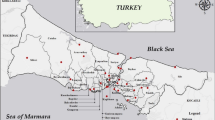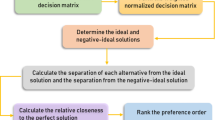Abstract
Detecting spatio-temporal patterns as an interesting topic from different perspectives like detecting anomalies, unexpected and high-risk areas is a powerful means to manage future events by describing the current state and giving the possibility to predict the future. Criminology theories explain that the distribution of crime is not random. Although various specifications of crime are necessary for crime analysis, three types of most important information are location, time and environment data. Therefore, spatio-temporal crime patterns recognition plays an important role in crime analysis. This paper presents a new approach to detect the space and time areas which the crimes are most likely to happen. For this aim, a genetic-fuzzy system is developed to generate an interpretable fuzzy knowledge base that encompasses patterns for predicting future spatio-temporal crimes. It composed of three steps: fuzzy partitioning of the problem space, selecting meaningful features, and constructing the fuzzy knowledge base. We evaluate our proposed system using both a simulated dataset and a real-world dataset from Tehran, Iran. The results show that the proposed system is a suitable tool to find patterns and predict future crimes for environments with clustered crimes in space and time.





Similar content being viewed by others
References
Achache S, Shlechtingen M, Raison M, Baron L, Santos I (2015) Adaptive neuro-fuzzy inference system models for force prediction of a mechatronic flexible structure. J Integr Design Proc Sci 19(3):77–94
Adams W, Herrmann C, Felson M (2015) Crime, transportation and malignant mixes. In Safety and Security in Transit Environments, pp. 181–195
Bezerra F, Wainer J (2012) A dynamic threshold algorithm for anomaly detection in logs of process aware systems. J Inform Data Manage, 316–331
Chainey S, Tompson L, Uhlig S (2008) The utility of hotspot mapping for predicting spatial patterns of crime. Security J 21(1–2):4–28
Chen S, Nembhard HB (2011) Multivariate Cuscore control charts for monitoring the mean vector in autocorrelated processes. IIE Trans 43(4):291–307
Cohen L, Felson M (1979) Social change and crime rate trends: a routine activity approach. Am Sociol Rev 44(4):588–608
Glaz J, Balakrishnan N (2012) Scan Statistics and Applications. Springer Science & Business Media
Ishibuchi H, Nojima Y (2007) Analysis of interpretability-accuracy tradeoff of fuzzy systems by multiobjective fuzzy genetics-based machine learning. Int J Approximate Reasoning 44(1):4–31
Knox G (1964) Epidemiology of childhood leukaemia in Northumberland and Durham. British J Preventive Social Med 18(1):17–24
Kuo P-F, Lord D, Walden T (2013) Using geographical information systems to organize police patrol routes effectively by grouping hotspots of crash and crime data. J Transp Geogr 30:138–148
Lahsasna A, Seng W (2017) An improved genetic-fuzzy system for classification and data analysis. Expert Syst Appl 83:49–62
Maciąg PS (2017) A survey on data mining methods for clustering complex spatiotemporal data. International Conference: Beyond Databases, Architectures and Structures, pp. 115–126
Malleson N (2011) Using agent-based models to simulate crime. In: Liu L, Eck J (Eds.), Agent-based models of geographical systems. Springer, pp. 411–434
Malleson N, Heppenstall A, See L, Evans A (2013) Using an agent-based crime simulation to predict the effects of urban regeneration on individual household burglary risk. Environ Plan B: Plan Design 40(3):405–426
McFowland E, Skyler S, Neill DB (2013) Fast generalized subset scan for anomalous pattern detection. J Machine Learning Res, 1533–1561
Newton A, Felson M (2015) Crime patterns in time and space: the dynamics of crime opportunities in urban areas. Crime Science, 4(11)
Ratcliffe J (2016) Intelligence-Led Policing. Routledge
Sedighiani K, HashemiKhabir S (2009) Constructing interpretable genetic fuzzy rule-based system for breast cancer diagnostic. WRI Global Congress on Intelligent Systems, (pp. 441–446). Xiamen, China
Shill P, Akhand M, Murase K (2011) Simultaneous design of membership functions and rule sets for type-2 fuzzy controllers using genetic algorithms. Comput Inform Technol (ICCIT), pp. 129–139. Dhaka, Bangladesh: IEEE
Tayebi M, Glasser U, Ester M, Brantingham P (2016) Personalized crime location prediction. Math Model Crime Security 27(3):422–450
Trawiński K, Cordón O, Sánchez L (2013) A genetic fuzzy linguistic combination method for fuzzy rule-based multiclassifiers. IEEE Trans Fuzzy Syst 21(5):950–965
Wang D, Ding W, Chen P, Morabito M, Salazar J, Chen P, Stepinski T (2013) Understanding the spatial distribution of crime based on its related variables using geospatial discriminative patterns. Comput Environ Urban Syst 39:93–106
Weir R et al. (2007) The use of geographic information systems by crime analysts in England and Wales. London: Home Office, Home Office Online Report Series
Yazdanbakhsh O, Zhou Y, Dick S (2017) An intelligent system for livestock disease surveillance. Inf Sci 378:26–47
Author information
Authors and Affiliations
Corresponding author
Additional information
Publisher's Note
Springer Nature remains neutral with regard to jurisdictional claims in published maps and institutional affiliations.
Rights and permissions
About this article
Cite this article
Farjami, Y., Abdi, K. A genetic-fuzzy algorithm for spatio-temporal crime prediction. J Ambient Intell Human Comput (2021). https://doi.org/10.1007/s12652-020-02858-3
Received:
Accepted:
Published:
DOI: https://doi.org/10.1007/s12652-020-02858-3




